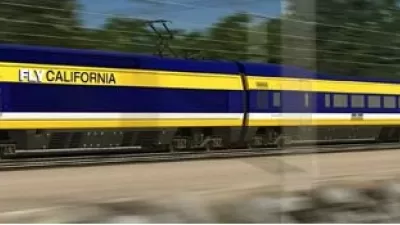One positive thing to be said about a project that's been declared on life support by even many of its supporters since a court ruling denied its chief funding source: the Calif. HSR Authority sure is resilient. New funding sources may keep it alive.
Back in January when Gov. Jerry Brown announced that he would tap AB 32's cap and trade fund (technically called the Greenhouse Gas Reduction Fund), I had regrettably characterized it as a "Hail Mary Pass". Clearly, it wasn't. It was more like the major game plan for the governor's embattled rail project.
The Wall Street Journal's California correspondent, Alejandro Lazo, elaborates on the funding possibilities that the rail authority is considering using with the GHG Reduction Fund allocation as its base.
Securing cap-and-trade dollars for the project could give the state's high-speed rail authority an important boost by providing a stable source of funding, experts said. The state said it could tap federal loans through the Transportation Infrastructure Finance and Innovation Act (TIFIA) or the Railroad Rehabilitation and Improvement Financing program
The state also said it could use private activity bonds, issued by a state for a public project for private users, as well as private sources such as bank loans, taxable bonds and equity investment.
There are several caveats to this approach.
- The governor places the allocation in his budget, but it is the legislature that approves it and authorizes the spending. According to Kathy Hamilton of Cal Watchdog in Part 3 of a series on California’s high-speed rail blueprint, "Gov. Jerry Brown sought $250 million in the next budget cycle for the high-speed rail project. In the future, he also wants to take one-third of the money from the state’s quarterly cap-and-trade auctions of greenhouse gas emission credits."
- There will be lots of competing requests for this new source of funding which will grow considerably next year with the addition of motor vehicle fuels. Senate Leader Darrell Steinberg (D-Sacramento) dropped his proposal to apply a carbon tax to those fuels in lieu of carbon trading.
- The state's non-partisan legislative analyst indicates that the project emits rather than reduces greenhouse gases during its construction which technically may violate AB 32 policies.
- Finally, AB 32 terminates in 2020 - it will have to be renewed. We posted an article about a bill introduced to do just that.
In any case, tapping (or draining, depending on one's perspective) the Greenhouse Gas Reduction Fund "would give the authority more credibility and, at least up to the amount guaranteed, they wouldn't have to go begging the legislature for money every year," said Louis S. Thompson, chairman of the California High-Speed Rail Peer Review Group, an independent overseer of the project."
FULL STORY: California Eyes Plan for Bullet Train

Alabama: Trump Terminates Settlements for Black Communities Harmed By Raw Sewage
Trump deemed the landmark civil rights agreement “illegal DEI and environmental justice policy.”

Study: Maui’s Plan to Convert Vacation Rentals to Long-Term Housing Could Cause Nearly $1 Billion Economic Loss
The plan would reduce visitor accommodation by 25% resulting in 1,900 jobs lost.

Why Should We Subsidize Public Transportation?
Many public transit agencies face financial stress due to rising costs, declining fare revenue, and declining subsidies. Transit advocates must provide a strong business case for increasing public transit funding.

Paris Bike Boom Leads to Steep Drop in Air Pollution
The French city’s air quality has improved dramatically in the past 20 years, coinciding with a growth in cycling.

Why Housing Costs More to Build in California Than in Texas
Hard costs like labor and materials combined with ‘soft’ costs such as permitting make building in the San Francisco Bay Area almost three times as costly as in Texas cities.

San Diego County Sees a Rise in Urban Coyotes
San Diego County experiences a rise in urban coyotes, as sightings become prevalent throughout its urban neighbourhoods and surrounding areas.
Urban Design for Planners 1: Software Tools
This six-course series explores essential urban design concepts using open source software and equips planners with the tools they need to participate fully in the urban design process.
Planning for Universal Design
Learn the tools for implementing Universal Design in planning regulations.
Smith Gee Studio
Alamo Area Metropolitan Planning Organization
City of Santa Clarita
Institute for Housing and Urban Development Studies (IHS)
City of Grandview
Harvard GSD Executive Education
Toledo-Lucas County Plan Commissions
Salt Lake City
NYU Wagner Graduate School of Public Service




























